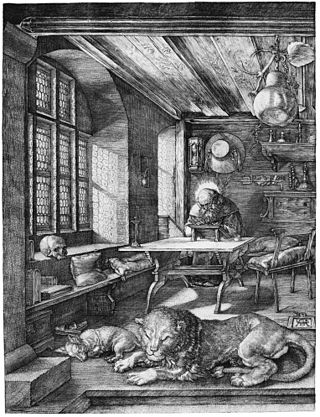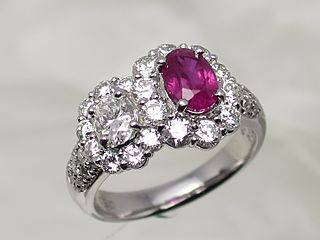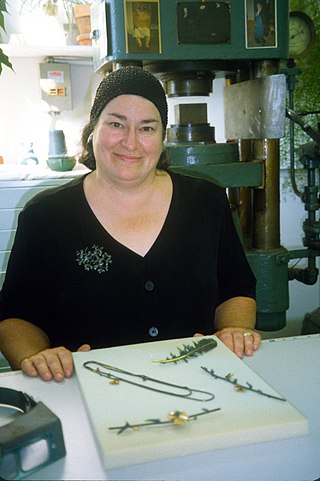

Handmade jewelry/jewellery, or handcrafted jewelry/jewellery, is jewelry that has been assembled and formed by hand rather than through the use of machines.
Contents
The oldest handmade jewelry trademark is in Florence, Italy. [1]


Handmade jewelry/jewellery, or handcrafted jewelry/jewellery, is jewelry that has been assembled and formed by hand rather than through the use of machines.
The oldest handmade jewelry trademark is in Florence, Italy. [1]
According to the guidelines of the U.S. Federal Trade Commission, in order to be stamped or called "handmade" in United States, the work must be made solely by hand power or hand guidance. [2] This means that jewelry may be made using drills, lathes, or other machinery, but it must be guided by the human hand.[ original research? ]
This precludes the use of hand procedures such as hammering, doming, sawing, filing, soldering, finishing, punch presses, CNC machinery, and casting, to name a few processes the use of which would make the jewelry not qualify as "handmade". Beyond that, handmade jewelry can be made out of any material and with a wide variety of techniques. Advantages It allows exclusivity as each item is unique It exhibits the individuality and exclusivity of craftsmen
Handmade jewellery and handicrafts are a part of culture in many parts on the world. Handmade jewelry can be made using any materials and techniques provided they are manually done. Some of these handmade jewels are quite popular around the world. Based on the materials used and styles adopted, there are many types of handmade jewelry,
Awards for handmade jewelry include:

Agate is the banded variety of chalcedony, which comes in a wide variety of colors. Agates are primarily formed within volcanic and metamorphic rocks. The ornamental use of agate was common in Ancient Greece, in assorted jewelry and in the seal stones of Greek warriors, while bead necklaces with pierced and polished agate date back to the 3rd millennium BCE in the Indus Valley civilisation.

A bead is a small, decorative object that is formed in a variety of shapes and sizes of a material such as stone, bone, shell, glass, plastic, wood, or pearl and with a small hole for threading or stringing. Beads range in size from under 1 millimeter (0.039 in) to over 1 centimeter (0.39 in) in diameter.

A gemstone is a piece of mineral crystal which, when cut or polished, is used to make jewelry or other adornments. Certain rocks and occasionally organic materials that are not minerals may also be used for jewelry and are therefore often considered to be gemstones as well. Most gemstones are hard, but some softer minerals such as brazilianite may be used in jewelry because of their color or luster or other physical properties that have aesthetic value. However, generally speaking, soft minerals are not typically used as gemstones by virtue of their brittleness and lack of durability.

Jewellery consists of decorative items worn for personal adornment, such as brooches, rings, necklaces, earrings, pendants, bracelets, and cufflinks. Jewellery may be attached to the body or the clothes. From a western perspective, the term is restricted to durable ornaments, excluding flowers for example. For many centuries metal such as gold often combined with gemstones, has been the normal material for jewellery, but other materials such as glass, shells and other plant materials may be used.

Topaz is a silicate mineral made of aluminum and fluorine with the chemical formula Al2SiO4(F, OH)2. It is used as a gemstone in jewelry and other adornments. Common topaz in its natural state is colorless, though trace element impurities can make it pale blue or golden brown to yellow-orange. Topaz is often treated with heat or radiation to make it a deep blue, reddish-orange, pale green, pink, or purple.

Chalcedony ( kal-SED-ə-nee, or KAL-sə-doh-nee) is a cryptocrystalline form of silica, composed of very fine intergrowths of quartz and moganite. These are both silica minerals, but they differ in that quartz has a trigonal crystal structure, while moganite is monoclinic. Chalcedony's standard chemical structure (based on the chemical structure of quartz) is SiO2 (silicon dioxide).

Engraving is the practice of incising a design onto a hard, usually flat surface by cutting grooves into it with a burin. The result may be a decorated object in itself, as when silver, gold, steel, or glass are engraved, or may provide an intaglio printing plate, of copper or another metal, for printing images on paper as prints or illustrations; these images are also called "engravings". Engraving is one of the oldest and most important techniques in printmaking. Wood engraving is a form of relief printing and is not covered in this article, same with rock engravings like petroglyphs.

A goldsmith is a metalworker who specializes in working with gold and other precious metals. Nowadays they mainly specialize in jewelry-making but historically, goldsmiths have also made silverware, platters, goblets, decorative and serviceable utensils, and ceremonial or religious items.

A brooch is a decorative jewellery item designed to be attached to garments, often to fasten them together. It is usually made of metal, often silver or gold or some other material. Brooches are frequently decorated with enamel or with gemstones and may be solely for ornament or serve a practical function as a clothes fastener. The earliest known brooches are from the Bronze Age. As fashions in brooches changed rather quickly, they are important chronological indicators. In archaeology, ancient European brooches are usually referred to by the Latin term fibula.

Wearable art, also known as Artwear or "art to wear", refers to art pieces in the shape of clothing or jewellery pieces. These pieces are usually handmade, and are produced only once or as a very limited series. Pieces of clothing are often made with fibrous materials and traditional techniques such as crochet, knitting, quilting, but may also include plastic sheeting, metals, paper, and more. While the making of any article of clothing or other wearable object typically involves aesthetic considerations, the term wearable art implies that the work is intended to be accepted as an artistic creation or statement. Wearable art is meant to draw attention while it is being displayed, modeled or used in performances. Pieces may be sold and exhibited.

Idar-Oberstein is a town in the Birkenfeld district in Rhineland-Palatinate, Germany. As a Große kreisangehörige Stadt, it assumes some of the responsibilities that for smaller municipalities in the district are assumed by the district administration. Today's town of Idar-Oberstein is the product of two rounds of administrative reform, one in 1933 and the other in 1969, which saw many municipalities amalgamated into one. The various Stadtteile have, however, retained their original identities, which, aside from the somewhat more urban character encountered in Idar and Oberstein, tend to hark back to each centre's history as a rural village. Idar-Oberstein is known as a gemstone town, and also as a garrison town. It is also the largest town in the Hunsrück.
In modern Western body piercing, a wide variety of materials are used. Some cannot be autoclaved, and others may induce allergic reactions, or harbour bacteria. Certain countries, such as those belonging to the EU, have legal regulations specifying which materials can be used in new piercings.

A ring is a round band, usually made of metal, worn as ornamental jewelry. The term "ring" by itself denotes jewellery worn on the finger; when worn as an ornament elsewhere, the body part is specified within the term, e.g., earrings, neck rings, arm rings, and toe rings. Rings fit snugly around or in the part of the body they ornament, so bands worn loosely, like a bracelet, are not rings. Rings may be made of almost any hard material: wood, bone, stone, metal, glass, jade, gemstone or plastic. They may be set with gemstones or with other types of stone or glass.

Art jewelry is one of the names given to jewelry created by studio craftspeople. As the name suggests, art jewelry emphasizes creative expression and design, and is characterized by the use of a variety of materials, often commonplace or of low economic value. In this sense, it forms a counterbalance to the use of "precious materials" in conventional or fine jewelry, where the value of the object is tied to the value of the materials from which it is made. Art jewelry is related to studio craft in other media such as glass, wood, plastics and clay; it shares beliefs and values, education and training, circumstances of production, and networks of distribution and publicity with the wider field of studio craft. Art jewelry also has links to fine art and design.

Jewellery design is the art or profession of designing and creating jewellery. It is one of civilization's earliest forms of decoration, dating back at least 7,000 years to the oldest-known human societies in Indus Valley Civilization, Mesopotamia and Egypt. The art has taken many forms throughout the centuries, from the simple beadwork of ancient times to the sophisticated metalworking and gem-cutting known in the modern day.

Bohemian glass, also referred to as Bohemia crystal, is glass produced in the regions of Bohemia and Silesia, now parts of the Czech Republic. It has a centuries long history of being internationally recognised for its high quality, craftsmanship, beauty and often innovative designs. Hand-cut, engraved, blown and painted decorative glassware ranging from champagne flutes to enormous chandeliers, ornaments, figurines and other glass items are among the best known Czech exports and immensely popular as tourist souvenirs. The Czech Republic is home to numerous glass studios and schools attended by local and foreign students.
Deep Blue Sea is a hat designed by Australian milliner, Ann-Maree Willett, which is made from Australian wool felt and set with 26 precious opals from Lightning Ridge, weighing a total of 1447.5 carats.

The Middle Ages was a period that spanned approximately 1000 years and is normally restricted to Europe and the Byzantine Empire. The material remains we have from that time, including jewelry, can vary greatly depending on the place and time of their creation, especially as Christianity discouraged the burial of jewellery as grave goods, except for royalty and important clerics, who were often buried in their best clothes and wearing jewels. The main material used for jewellery design in antiquity and leading into the Middle Ages was gold. Many different techniques were used to create working surfaces and add decoration to those surfaces to produce the jewellery, including soldering, plating and gilding, repoussé, chasing, inlay, enamelling, filigree and granulation, stamping, striking and casting. Major stylistic phases include barbarian, Byzantine, Carolingian and Ottonian, Viking, and the Late Middle Ages, when Western European styles became relatively similar.
Curtis Australia is an Australian manufacturing company of luxury goods, based in Melbourne. Products manufactured by the company are handcrafted jewellery, watches and writing implements such as fountain, ballpoint and rollerball pens.

Jan Yager is an American artist who makes mixed media jewelry. She draws inspiration from both the natural world and the lived-in human environment of her neighborhood in Philadelphia, Pennsylvania, emphasizing that art is a reflection of both time and place. She has incorporated rocks, bullet casings, and crack cocaine vials into her works, and finds beauty in the resilience of urban plants that some would consider weeds.